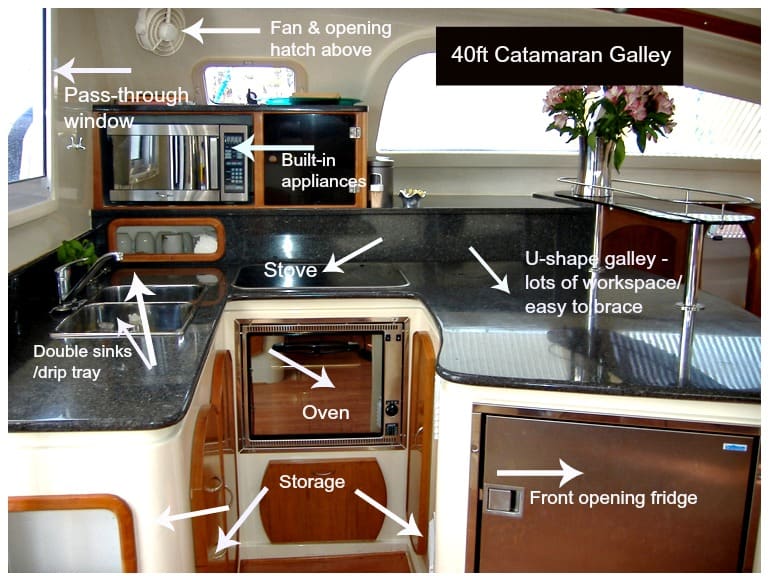Overseas Radio Network – Pantry for Self-Reliance, Extending Food Life, Foreign Food Markets
 In Overseas Radio Network Show 7, Segment 2, we continue our discussion about getting off the grid:
In Overseas Radio Network Show 7, Segment 2, we continue our discussion about getting off the grid:
- Important features of a self-reliant pantry
- Extending the life of foods on board
- Expect the unexpected in foreign food markets
GARY FRETZ: Welcome back to our show. I am Gary Fretz and we are talking today about getting off the grid. And my guest hosts today are Stephen and Estelle Cockcroft. And Estelle is going to tell us about what to look for in a galley on a boat because you are the expert in galleys. [See more of Estelle’s tips about galley designs on catamarans and choosing your catamaran galley.]
GARY FRETZ: Welcome back to our show. I am Gary Fretz and we are talking today about getting off the grid. And my guest hosts today are Stephen and Estelle Cockcroft. And Estelle is going to tell us about what to look for in a galley on a boat because you are the expert in galleys. [See more of Estelle’s tips about galley designs on catamarans and choosing your catamaran galley.]
For a transcript of this podcast, click “read more” below.
ESTELLE COCKCROFT: Yes, that’s what Stephen would like everybody to believe. The whole purpose of going cruising is to be self-reliant, to be independent, to have the freedom to do things that start you off the grid. And to be able to do that you have to set up your boat that way. You can’t just, when you are in the middle of nowhere, you can’t just pop into the Giant or Publix [these are grocery stores of the xsoutheast United States] to go in and get some fresh vegetables.
So you want to set up your galley so that you have space for all of these things, remembering that you have a small space to work with so don’t over supply. Don’t overstock, over provision. So first of all what I look for in a galley is that it is big enough for storage. Obviously you have to have your pots and pans. And I like to entertain well, so I have my crystal glasses and my crockery and so forth. A little ridiculous on a sailboat, but I do like to have that little nice extra on my boat.
Stephen built me a really nice big pantry so that I can store the bigger stuff like the flour, oil, and so on. Stephen mentioned the wine cellar which is particularly big on our boat. And then, of course, my fridge and freezer, the fridge has to be big enough to store Stephen’s beer first and foremost. Has to be front opening because the older you get, the less you want to bend to dig in to fridge to want to find stuff so that is quite important.
A freezer, a good freezer, is important for me. Not all boats can have that. But if you can, instead of an icebox, get a good freezer. The stove is important obviously. I love baking. That’s one of the things I do well. So my stove and oven has to be good quality. And then we tend to barbeque a lot so barbeques is one of the most important equipment on our boat. So we spend quite a bit of money on our barbeque so that we have the best quality.
Stephen, you want to add something to that? Not that you would know too much about the galley.
STEPHEN COCKCROFT: Well, that’s what happens, you know. You get a barbeque so Estelle can get me to start cooking. But at least cooking, you are allowed to drink a beer, which is nice. But we have a propane barbeque. It is a little bit easier than carrying charcoal and going ashore chopping trees down.
Couple of things though, the refrigeration system I recommend should be 12 volt so that you don’t have to run any machinery to run them. You’re getting free power through your solar panels and that charges your batteries which gives you free refrigeration, of course, wind generator is Estelle’s favorite. But, you know, you get different systems where you get engine-driven refrigeration, etc. but that means that you got to burn diesel and the whole object of the exercise is to be off the grid and to be as independent as possible.
Another little trick we learned, this was in the Indian Ocean when we cruising in the really, really deserted place. Is that we would carry our own flour and rice in bulk. And we discovered that it got really tasty. Got sort of a meaty taste to it because there were weevils in it. So this Australian fellow explains to us that the best thing to do is get some dry ice and pop the dry ice into the drum and then pour all your bag of rice into the drum. And then you wait until the carbon dioxide starts overflowing the lid and once it’s all dissolved you put the lid on and now you have completely sealed your food because nothing can survive without oxygen. So that was a little trick we learned how to preserve foods for the long period.
ESTELLE: Remember, Stephen, though that we were in the third world and things like zip lock bags was not available. And if you could get it, it was very expensive. Nowadays, it is different. You can buy flour in 2 kilo or 2 lbs bags and you can zip lock it very safely and you won’t have the problem with weevils. The same thing with rice, etc.
So we have come a long way. I use to make my own yogurt. We used to preserve cheese in cheese cloths in the bilges…deep, deep bilges. You know, again, today we don’t need to do all those things since we have better refrigeration and bigger boats. But, you know, if you cruise in the third world, these are the things you have to learn. Things that I didn’t know existed at the time like tin butter and of course that stuff turns rancid in no time. But you’re really, really happy to have it. And then we tend to live off the land there as much as we could, getting fruits and so forth from.
STEPHEN: Tell them about the chicken you particularly liked the chicken from Madagascar.
ESTELLE: The first time I went to the market in Madagascar was quite a disaster for me. I was used to getting nice packaged meat in the refrigeration section in the supermarket. Well not so much in Madagascar. I bought a chicken and when I opened the white plastic bag on the boat the chicken was full of feathers and it had its feet on.
I didn’t know that chicken came with feathers so that was quite a learning curve for me. Of course, we were excited about getting meat in Madagascar. We went to the market at 4:00 p.m. as we were advised we get there to witnessed the guy slaughtering the zobo meat. The zobo and the blood running down the gutters and it was quite an experience. You know, these things you get used to because you have to eat. So those were my experiences, Gary.
GARY: Wow, well I would like to add something about galleys and, of course, our boat of choice is the catamaran because it really makes the best liveaboards. And you can find them with either what we call galley up or galley down. And galley down would mean it’s down in one of the halls and you are sort of away from the group and some people like that version of layout because you can make a mess and if you are having a party, it is not seen by everybody.
But I actually prefer a galley up. Estelle does, too. And that would be where you have the galley in the salon and you usually have a counter that serves as a breakfast bar. And you have some stools and it doubles like a pub at night. So it makes a great party layout too when you have guests over.
Well that’s about if for this segment. We will be right back after this short break. You are listening to “Yachts: The Perfect Escape Vehicle” and only on the Overseas Radio Network and this is Gary Fretz.






